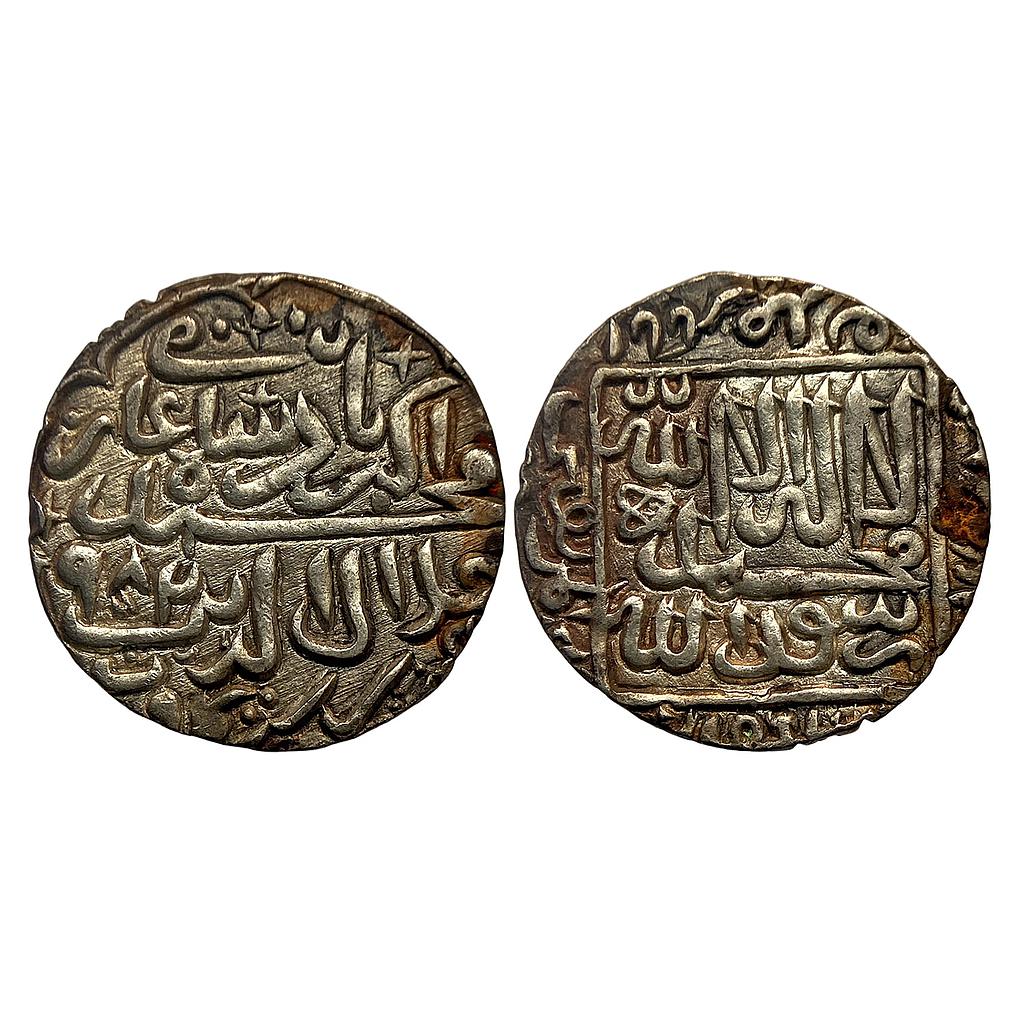Lot 348
Mughal Akbar Kalima type Satgaon Mint Silver Rupee
Auction # 16 Kolkata e-Auction-cum-Floor Auction
- Estimated Price (INR)
- 135000 - 150000
- Price Realised -
-
Auction Completed!
- Catalog Reference #
- Lid-S7, unlisted in KM
- Metal Composition
- Silver
- Lot Grade/Condition
- extra fine+
- Diameter
- 28.90 mm
- Weight
- 11.37 gms
- Denomination
- Rupee
- Calendar/Year
- AH 963-1014, 1556-1605 AD
Mughal, Akbar (AH 963-1014, 1556-1605 AD), Silver Rupee, Kalima type, 11.37 gms, 28.90 mm, Satgaon Mint, AH 982, Struck during the year of Akbar's conquest of Satgaon from the Bengal sultans, Lid-S7, unlisted in KM, extra fine+, extremely rare, a highly exclusive issue, no other pieces sold in recent years, this great rarity missing in all major collections.
Between AH 960 and 971 (AD 1552-63) much of Bengal was ruled by members of a Suri dynasty. The precise extent of their domains is difficult to ascertain; it is probable that their sway extended into parts of Bihar whilst a good deal of Eastern Bengal seems to have been in the hands of local chieftains, not to mention the Portuguese. In 971 (1563) Sulaiman Kararani, one time governor of Bihar under Sher Shah Suri seized power in Bengal, but died the following year. His elder son, Bayazid, succeeded him briefly before being assassinated and replaced by his younger brother Daud. Whereas Sulaiman had acknowledged Akbar's authority, Daud did not, going so far as to invade Mughal territory to the West. Akbar sent Mun'im Khan against him and Daud was forced to retreat to Patna where he was besieged. Difficulties experienced by Mun'im during the siege persuaded Akbar to set out himself. He captured Hajipur and then Patna. Daud meanwhile had fled and Akbar pursued him as far as Daryapur. Mun'im then re-joined Akbar and was given the task of completing the conquest of Bengal while Akbar returned to Delhi. Mun'im made good progress and was soon in occupation of Daud's capital, Tanda. From there the Mughal armies captured Ghoraghat, Satgaon and Burdwan. After meeting with some resistance, they defeated Daud at the battle of Bajhaura and the latter subsequently sued for peace. All this took place in the year 982 (1574-5). Mughal rejoicing, however, was to prove short-lived as Daud again rebelled and it took another couple of years before Daud was finally caught and executed in 984, and Bengal became once again part of the Mughal empire. The rupee offered here was struck at Satgaon in AH 982 and must have been issued to mark the Mughal occupation of the town mentioned above. Satgaon, the ancient Saptagrama, had been an important commercial port for centuries. Coins were struck there in the name of the Delhi Sultan, Muhammad bin Tughluq and Sher Shah and Islam Shah Suri' as well as Jalal Shah. Other coins bear the legend 'Arsah Satgaon or Mulk Satgaon', apparently referring to the administrative area or even province of Satgaon. Towards the end of his reign in 943/944 (1536/7) Mahmud 111 of Bengal had given the Portuguese important commercial powers in Satgaon (and Chittagong) in return for assistance rendered in his defence against Sher Shah Suri. The city was situated on the river Saraswati, through which flowed the main stream of the Hughli river. But in the second half of the 16th century AD the course of the main stream changed causing the river Saraswati to silt up. As a result, larger vessels could no longer reach Satgaon, and that city declined in importance, to be replaced by the growing city of Hughli a little to the south. Hughli was founded by the Portuguese, who at this period virtually controlled the eastern seaboard and enjoyed extensive commercial powers. What role, if any, the Portuguese played in the conflict between the Mughals and Daud Kararani is unclear.
